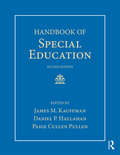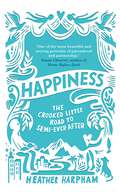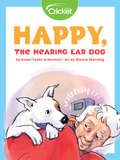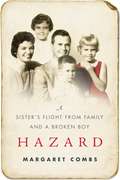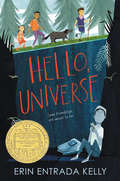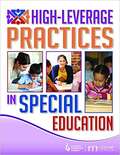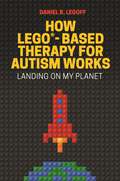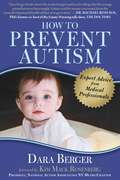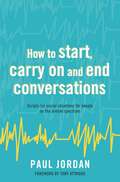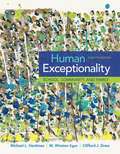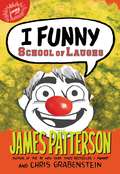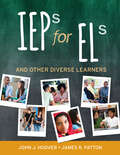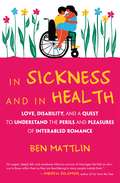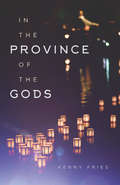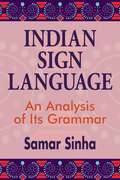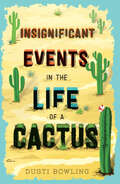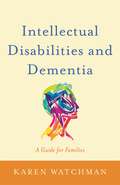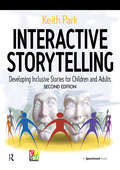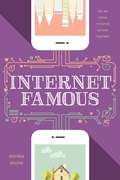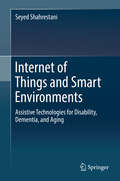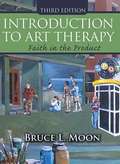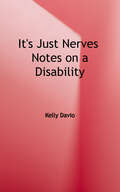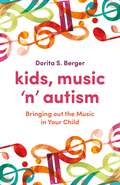- Table View
- List View
Handbook of Special Education
by Daniel P. Hallahan James M. Kauffman Paige Cullen PullenThe purpose of the Handbook of Special Education is to help profile and bring greater clarity to the already sprawling and continuously expanding field of special education. To ensure consistency across the volume, chapter authors review and integrate existing research, identify strengths and weaknesses, note gaps in the literature, and discuss implications for practice and future research. The second edition has been fully updated throughout to take into account recent changes to federal laws as well as the most current academic research, and an entirely new section has been added on research methods in special education.
Happiness: How to Build a Family out of Love and Spare Parts
by Heather HarphamReese Witherspoon's Book Club Pick 2018 An Amazon Best Memoir of the Month One of Elle Magazine's Best Books of 2017 Goodreads Best of the Month Daily Beast, &“Books I Can&’t Live Without&” Good Housekeeping, Best New Books for Summer Book Riot, 100 Must Read Books about Happiness A page-turning, shirt-grabbing true story that follows a one-of-a-kind family required to make nearly unimaginable choices Happiness starts out as a charming courtship between hopelessly attracted opposites: Heather, an out-going, theatre-performing California girl, and Brian, an intellectual New Yorker with an unwavering writing routine. But when Heather falls pregnant, their magical interlude abruptly ends—Brian loves her, only he doesn&’t want kids. So Heather decides to have their baby alone. Mere hours after Gracie&’s arrival, Heather&’s bliss is interrupted when a nurse wakes her, 'Get dressed, your baby is in trouble.' This is not how Heather had imagined motherhood. As concerns for her health grow, Brian and Heather begin a cautious return to each other. Happiness transforms heartbreak and parental fears into a lyrical meditation on love and happiness, in all their crooked configurations.
Happy, the Hearing Ear Dog
by Susan Yoder AckermanTyler's grandma is deaf, so she gets Happy, a specially trained dog who hears for her.
Hazard: A Sister's Flight from Family and a Broken Boy
by Margaret CombsHazard is a poignant, unflinching memoir of the emotional intricacies of growing up with a severely disabled sibling. Margaret Combs shows how her Southern Baptist family coped with lived reality of autism in an era of ignorance and shame, the 1950s through the 1970s, and shares her own tragedy and anguish of being torn between helping her brother and yearning for her own life. Like many siblings of disabled children, young Margaret drives herself to excel in order to make up for her family’s sorrow and ultimately flees her family for what she hopes is a ?normal” life.Hazard is also a story of indelible bonds between siblings: the one between Combs and her sister, and the deep and rueful one she has with her disabled brother; how he and she were buddies; and how fervently she wanted to make him whole. Initially fueled by a wish that her brother had never been born, the author eventually arrives in a deeper place of gratitude for this same brother, whom she loves and who loves her in return.
Helen Keller (Readers Bios)
by Kitson JazynkaReaders will be inspired by the amazing story of Helen Keller in this informative biography. They will learn all about her life, her achievements, and the challenges she faced along the way. The Level 2 text provides accessible, yet wide-ranging, information for independent readers.
Hello, Universe
by Erin Entrada Kelly Isabel Roxas<P>Acclaimed and award-winning author Erin Entrada Kelly’s Hello, Universe is a funny and poignant neighborhood story about unexpected friendships. <P>Told from four intertwining points of view—two boys and two girls—the novel celebrates bravery, being different, and finding your inner bayani (hero), and it’s perfect for fans of Lynda Mullaly Hunt, Thanhha Lai, and Rita Williams-Garcia. In one day, four lives weave together in unexpected ways. Virgil Salinas is shy and kindhearted and feels out of place in his crazy-about-sports family. Valencia Somerset, who is deaf, is smart, brave, and secretly lonely, and she loves everything about nature. Kaori Tanaka is a self-proclaimed psychic, whose little sister, Gen, is always following her around. And Chet Bullens wishes the weird kids would just stop being so different so that he can concentrate on basketball. <P>They aren’t friends, at least not until Chet pulls a prank that traps Virgil and his pet guinea pig at the bottom of a well. This disaster leads Kaori, Gen, and Valencia on an epic quest to find the missing Virgil. Sometimes four can do what one cannot. Through luck, smarts, bravery, and a little help from the universe, a rescue is performed, a bully is put in his place, and friendship blooms. <P>The acclaimed author of Blackbird Fly and The Land of Forgotten Girls writes with an authentic, humorous, and irresistible tween voice that will appeal to fans of Thanhha Lai and Rita Williams-Garcia. <P> <b>A New York Times Bestseller </b> <P><b>Winner of the Newberry Medal</b>
High-Leverage Practices In Special Education: The Final Report of the HLP Writing Team
by Council for Exceptional Children Ceedar CenterSpecial education teachers, as a significant segment of the teaching profession, came into their own with the passage of Public Law 94-142, the Education for All Handicapped Children Act, in 1975. Since then, although the number of special education teachers has grown substantially it has not kept pace with the demand for their services and expertise. The roles and practice of special education teachers have continuously evolved as the complexity of struggling learners unfolded, along with the quest for how best to serve and improve outcomes for this diverse group of students. High-Leverage Practices in Special Education defines the activities that all special educators needed to be able to use in their classrooms, from Day One. HLPs are organized around four aspects of practice collaboration, assessment, social/emotional/behavioral practices, and instruction because special education teachers enact practices in these areas in integrated and reciprocal ways. The HLP Writing Team is a collaborative effort of the Council for Exceptional Children, its Teacher Education Division, and the CEEDAR Center; its members include practitioners, scholars, researchers, teacher preparation faculty, and education advocates.
How LEGO®-Based Therapy for Autism Works: Landing on My Planet
by Daniel B. Legoff"You know, Dr. Dan, that kid is from my planet." With in-depth descriptions of LEGO®-based therapy in action, this book explains how and why it helps to promote the development of social skills for children with autism spectrum disorders (ASDs) and related conditions. Written by Daniel B. LeGoff, who pioneered the approach, this book comprises a series of case histories of children who participated in LEGO® therapy. It traces the development of the evidence-based approach, shares the clinical insights gained along the way and highlights the principles which should be at the core of all effective treatment and educational strategies for children with ASDs. The case histories have real practical value for those working with children with ASDs and also help to demonstrate the subtleties of the adult facilitation role for professionals running sessions.
How to Prevent Autism: Expert Advice from Medical Professionals
by Scott Smith Katie Wright James Lyons-Weiler Kim Mack Rosenberg Dara Berger Dr Sidney Baker Dr Nancy O'Hara Geri Brewster Maureen McDonnel Dr Anju Usman Dr Stephanie Seneff Maria Rickert-Hong Corinne Simpson BrownThe statistics are alarming and become more so every year. The Centers for Disease Control and Prevention estimates that 1 in 68 children have been identified with an autism spectrum disorder, making it one of the fastest growing developmental disorders in the United States. Further, the CDC estimates that parents with a child on the autism spectrum can have nearly a 20 percent chance of having a second child with autism.In How to Prevent Autism, Dara Berger shares her personal journey with autism. She describes everything that went wrong with her son that led to an autism diagnosis and everything she did differently to prevent her daughter from suffering the same fate. She interviews eight well-known ASD experts--including doctors, nutritionists, nurses, and scientists--about the factors that have led to the growing epidemic of autism. Based on the best practices for preventing autism in children, each professional offers perspectives grounded in their own research and their patients’ improvements. The book covers every detail--from the importance of mothers’ cleaning out their bodies preconception, through common genetic mutations that may put children at risk, to the crucial role of nutrition in prevention.All parents agree that every choice counts when it comes to the health of their children. As Dara Berger makes clear in this personal, informative, and authoritative book, the stakes could not be higher when it comes to autism.
How to start, carry on and end conversations: Scripts for social situations for people on the autism spectrum
by Tony Attwood Paul JordanDo you find it hard to make friends? Do you struggle to know what to say to start a conversation? In this book, Paul Jordan, who is on the autism spectrum, explains how to make sense of everyday social situations you might encounter at school, university or in other group settings. He reveals how, with the use of just 65 simple words, it is possible to create 'scripts for thinking' that break conversations down into small chunks and help you to think of what to say, whether you are speaking to a fellow student, starting a conversation with a new friend, calling out bullies or answering a teacher's question. These small words will be a big help for all teenagers and young people with ASD.
Human Exceptionality: School, Community, And Family
by Michael L. Hardman Clifford J. Drew M. Winston EganExpanding on its widely respected and unique focus on the critical role of professionals in education, psychology, counseling, health care, and human services, HUMAN EXCEPTIONALITY: SCHOOL, COMMUNITY, AND FAMILY, 12th Edition, is an evidence-based testament to how cross-professional collaboration enhances the lives of exceptional individuals and their families. This text's unique lifespan approach combines powerful research, evidence-based practices, and inspiring stories, engendering passion and empathy and enhancing the lives of individuals with exceptionalities. Designed to help students experience individuals with disabilities and their families in a personal and intimate fashion, HUMAN EXCEPTIONALITY is an excellent resource for preparing both preservice and practicing teachers, as well as a range of other human services professionals in the fields of psychology, sociology, social work, and the health sciences.
I Funny: School of Laughs (I Funny #5)
by James PattersonTo save his school library, Jamie Grimm teaches other kids how to tell jokes in a comedy class -- but it's tougher than he expects in this funny book for kids of all ages.Teaching other kids how to be funny is the toughest gig that Jamie Grimm has ever had, and with the highest stakes. If he fails, his school library will be shut down for good!Even though he has a national contest trophy and a TV show under his belt, Jamie Grimm isn't one to sit back and relax. When his school has a major funding crisis, Jamie hits on a bright idea to save the day -- a comedy class for the other students. Little does he know that making jokes and teaching jokes are two very different things . . . and he's only good at one of them. With the fate of his school's library on his shoulders, Jamie has to dig deep to see if he has what it takes to succeed at his most difficult challenge yet.
IEPs for ELs: And Other Diverse Learners
by James R. Patton John J. HooverDevelop and monitor high-quality IEPs for diverse learners High-quality IEPs are fundamental for guiding the educational process of and developing goals for students who require special education services. English learners (ELs) and other students with learning, emotional, or behavioral disabilities present unique challenges to educators responsible for referring, assessing, and placing them. IEPs for ELs provides educators with numerous research-based strategies and examples of how to write effective IEPs for these K-12 learners. John J. Hoover and James Patton, leading professionals in the areas of special education and linguistic diversity, share their research and how they have supported ELs who have, or are suspected of having, learning and intellectual disabilities. Readers will find: Practical guidance for developing and monitoring culturally and linguistically responsive IEPs Checklists, guides, and other reproducibles that support IEP development Case studies and vignettes highlighting examples of appropriate IEPs for diverse learners Filled with expert practical advice that covers the IEP process and walks the reader through the procedure for creating high-quality IEPs that take individual differences into account, this guide is essential for special educators and bilingual/EL specialists. "A major strength for this book is its unique tie to English learners, while providing a dual focus on IEP writing. This is a great tool to use when training new special education teachers and IEP facilitators. There are direct connections to writing legally defensible plans with a user-friendly focus on IEP writing. I see this book as a tool to support teachers and students in ensuring that language and cultural considerations are included when developing and updating individual plans." —Renee Bernhardt, Supervisor, Special Education Cherokee County School District, GA
IEPs for ELs: And Other Diverse Learners
by James R. Patton John J. HooverDevelop and monitor high-quality IEPs for diverse learners High-quality IEPs are fundamental for guiding the educational process of and developing goals for students who require special education services. English learners (ELs) and other students with learning, emotional, or behavioral disabilities present unique challenges to educators responsible for referring, assessing, and placing them. IEPs for ELs provides educators with numerous research-based strategies and examples of how to write effective IEPs for these K-12 learners. John J. Hoover and James Patton, leading professionals in the areas of special education and linguistic diversity, share their research and how they have supported ELs who have, or are suspected of having, learning and intellectual disabilities. Readers will find: Practical guidance for developing and monitoring culturally and linguistically responsive IEPs Checklists, guides, and other reproducibles that support IEP development Case studies and vignettes highlighting examples of appropriate IEPs for diverse learners Filled with expert practical advice that covers the IEP process and walks the reader through the procedure for creating high-quality IEPs that take individual differences into account, this guide is essential for special educators and bilingual/EL specialists. "A major strength for this book is its unique tie to English learners, while providing a dual focus on IEP writing. This is a great tool to use when training new special education teachers and IEP facilitators. There are direct connections to writing legally defensible plans with a user-friendly focus on IEP writing. I see this book as a tool to support teachers and students in ensuring that language and cultural considerations are included when developing and updating individual plans." —Renee Bernhardt, Supervisor, Special Education Cherokee County School District, GA
In Sickness and in Health: Love, Disability, and a Quest to Understand the Perils and Pleasures ofInterabled Romance
by Ben MattlinA frank, humorous exploration of interabled dating, love, and marriageBen Mattlin’s wife, ML, recalls falling in love with his confidence and sheer determination. On one of their earliest dates, he persuaded her to ride on his lap in his wheelchair on their way home from an Elvis Costello concert. Thirty years later, they still travel like this from time to time, undaunted by the curious stares following them down the street.But In Sickness and in Health is more than an “inspiring” story of how a man born with spinal muscular atrophy—a congenital and incurable neuromuscular condition—survived childhood, graduated from Harvard, married an able-bodied woman, built a family with two daughters and a cat and a turtle, established a successful career in journalism, and lived happily ever after. As Mattlin considers the many times his relationship has been met with surprise or speculation by outsiders—those who consider his wife a “saint” or him just plain “lucky” for finding love—he issues a challenge to readers: why should the idea of an “interabled” couple be regarded as either tragic or noble?Through conversations with more than a dozen other couples of varying abilities, ethnic backgrounds, and orientations, Mattlin sets out to understand whether these pairings are as unusual as onlookers seem to think. Reflecting on his own experience he wonders: How do people balance the stresses of personal-care help with the thrill of romance? Is it possible that the very things that appear to be insurmountable obstacles to a successful relationship—the financial burdens, the physical differences, the added element of an especially uncertain future—could be the building blocks of an enviable level of intimacy and communication that other couples could only dream of?We meet Shane Burcaw, a twenty-three-year-old writer, who offers a glimpse of his first forays into dating with a disability. There’s Rachelle Friedman, the “paralyzed bride,” as the media refers to her, and her husband, discussing the joys and challenges of a new marriage and a growing family. And Christina Crosby and her partner, Janet Jakobsen, reflect on how Crosby’s disabling accident called for them to renegotiate their roles and expectations in their long-term relationship. What emerges is a candid glimpse into the challenges and joys of interabled love—from the first blush of sexual awakening to commitment and marriage and through to widowhood.
In the Province of the Gods
by Kenny FriesKenny Fries embarks on a journey of profound self-discovery as a disabled foreigner in Japan, a society historically hostile to difference. As he visits gardens, experiences Noh and butoh, and meets artists and scholars, he also discovers disabled gods, one-eyed samurai, blind chanting priests, and A-bomb survivors. When he is diagnosed as HIV positive, all his assumptions about Japan, the body, and mortality are shaken, and he must find a way to reenter life on new terms.
Indian Sign Language: An Analysis of Its Grammar
by Samar SinhaSamar Sinha presents pioneering research into the grammatical properties of Indian Sign Language (ISL), a language used by members of the Deaf community in India. This detailed and well-illustrated study describes the grammar of ISL and is supplemented by comparative and theoretical analyses in the core areas of sublexical structure, morphology, and syntax. Sinha offers a field-based, comprehensive analysis that covers topics such as o sign formation parameters o syllable structure o sonority hierarchy o semantics of space o pluralization strategies o phi-features o indexing and localization o agreement o word order He provides a description of the Indian Deaf community that serves to frame his analysis of ISL and highlights the need for greater awareness and acknowledgment of the language and its users. The lack of research on ISL in Indian academia has slowed efforts toward the standardization of ISL and the development of pedagogical materials. This work adds to the growing understanding of natural human language in general and ISL in particular. It also contributes to the empowerment of the Deaf community in India and will strengthen the efforts carried out by d/Deaf activists and researchers.
Insignificant Events in the Life of a Cactus (Life of a Cactus #1)
by Dusti Bowling&“Aven is a perky, hilarious, and inspiring protagonist whose attitude and humor will linger even after the last page has turned.&” —School Library Journal (Starred review) Aven Green loves to tell people that she lost her arms in an alligator wrestling match, or a wildfire in Tanzania, but the truth is she was born without them. And when her parents take a job running Stagecoach Pass, a rundown western theme park in Arizona, Aven moves with them across the country knowing that she&’ll have to answer the question over and over again. Her new life takes an unexpected turn when she bonds with Connor, a classmate who also feels isolated because of his own disability, and they discover a room at Stagecoach Pass that holds bigger secrets than Aven ever could have imagined. It&’s hard to solve a mystery, help a friend, and face your worst fears. But Aven&’s about to discover she can do it all . . . even without arms.Autumn 2017 Kids&’ Indie Next Pick Junior Library Guild Selection Library of Congress's 52 Great Reads List 2018
Intellectual Disabilities and Dementia: A Guide for Families
by Karen WatchmanDrawing on the author's first-hand experiences with families, this book provides crucial, accessible information and answers the difficult questions that often arise when a family member with an intellectual disability is diagnosed with dementia. Linking directly to policy and practice in both dementia and intellectual disability care, this book takes an outcome-focussed approach to support short, medium and long-term planning. With a particular emphasis on communication, the author seeks to ensure that families and organisations are able to converse effectively about a relative's health and care. The book looks at how to recognise when changes in the health of a relative with an intellectual disability could indicate the onset of dementia, as well as addressing common concerns surrounding living situations, medication and care plans. Each chapter is structured to identify strategies for support whilst working towards outcomes identified by families as dementia progresses.
Interactive Storytelling: Developing Inclusive Stories for Children and Adults
by Keith ParkInteractive storytelling, where the story is spoken or chanted, began as a way to include individuals with severe and profound learning disabilities in larger group activities, whether children at school or adults in day services. The stories are performed in call-and-response - one person calls out a line and the rest of the group respond either by calling back the same line or by calling out a pre-arranged response - and require no previous experience in drama or storytelling. They can be performed anywhere, by anyone. Various stories are explored, ranging from folktales and pantomime to poetry, the works of Charles Dickens, Shakespeare and stories from the Old Testament. Each extract details the full call-and-response for performing the story. This approach to storytelling can be used by teachers and group facilitators in a variety of settings and with any group of children or adults, irrespective of their level of disability. This hands-on manual will enable teachers, therapists, parents and anyone working with children or adults in community settings to use performance and recital to bring stories, drama and poetry to life for people of all abilities. 'This book is a useful resource...is simply written...is especially appropriate for people working with children and adults with speech, language and communication difficulties.' - Child Language Teaching and Therapy.
Internet Famous
by Danika Stone<P>An engaging and relatable novel for the digital age that perfectly captures the complicated interaction between what goes on in our real lives and what we say online. <P>Internet sensation Madison Nakama has it all! Her pop-culture rewatch site has a massive following, and fans across the world wait on her every post and tweet. And now Laurent, a fellow geek (and unfairly HOT French exchange student!), has started flirting with her in the comments section of her blog. But Laurent’s not the only one watching for Madi’s replies… Internet fame has a price, and their online romance sparks the unwanted attention of a troll. <P>When Madi’s “real life” hits a rough patch, she feels her whole world crumbling. With Laurent’s support, can Madi rally her friends across the globe to beat the troll, or will he succeed in driving her away from everything—and everyone—she loves? <P>Internet Famous is a fresh, contemporary young adult romance for the iGeneration from Danika Stone, author of All the Feels.
Internet of Things and Smart Environments
by Seyed ShahrestaniThis book is focused on the Internet of Things (IoT) services and smart environments that can be of assistance to the elderly and individuals living with dementia or some sensory impairment. The book outlines the requirements of the systems that aim to furnish some digital sensory or cognitive assistance to the individuals and their caregivers. Internet of Things and Smart Environments: Assistive Technologies for Disability, Dementia, and Aging covers the important evolutions of the IoT, the sensors, actuators, wireless communication and pervasive computing systems, and other enabling technologies that power up this megatrend infrastructure. The use of the IoT-based systems in improving the conventional assistive technologies and provisions of ambient assisted living are also covered. The book takes an impartial, and yet holistic, view to providing research insights and inspirations for more development works in the areas related to assistive IoT. It will show the potentials of using normally available interactive devices, like smartphones or smart TVs, which can be supplemented with low-cost gadgets or apps to provide assistive capabilities. It aims to accentuate the need for taking a comprehensive and combinatory view of the comprising topics and approaches that are based on the visions and ideas from all stakeholders. The book will examine these points and considerations to conclude with recommendations for future development works and research directions. This book can be of value to a diverse array of audience. The researchers and developers in healthcare and medicine, aged care and disability services, as well as those working in the IoT-related fields, may find many parts of this book useful and stimulating. It can be of great value to postgraduate and research students working in these areas. It can also be adapted for use in upper-level classroom courses relevant to communication and smart technologies, IoT applications, and assistive technologies. Many parts of the book can be of interest to the elderly and individuals living with a disability, as well as their families and caregivers. From an industry perspective, it can be of interest to software, hardware, and particularly app developers working on the IoT applications, smart homes and environments, and assistive technologies for the elderly and people living with disability or dementia.
Introduction to Art Therapy: Faith in the Product
by Bruce L. MoonThis book describes the essential elements of the process of facilitating therapeutic change in forming a foundation from which art therapists construct treatment plans and philosophies. Enhancements in this text include: an overview of the spectrum of theoretical orientations within art therapy; a brief history of practice in the United States; descriptions of applications that were not widely understood in 1994; and the most current and seasoned interpretation of how the author perceives the art therapy experience. In addition, the author presents exceptional case examples including client-prepared artwork that highlights the text. This book will inspire serious artists to become involved in art therapy, and encourage veteran art therapists to renew their vocations by living the process of art therapy. This book will be a valuable resource to medical and mental health professionals, occupational therapists, and other rehabilitation professionals that aspire to become more effective in reaching others.
It's Just Nerves: Notes on a Disability
by Kelly DavioWith equal parts wit and empathy, lived experience and cultural criticism, Kelly Davio's It's Just Nerves: Notes on a Disability explores what it means to live with an illness in our contemporary culture, whether at home or abroad. "When the body attacks itself, the crisis is not just of bones and blood, but of beauty and boundaries. 'Strange men have had their hands on me for days, ' Kelly Davio observes during a plasma treatment. Her skillful portrait of myasthenia gravis does not exist in a vacuum. It's Just Nerves is in keen dialogue with the world around us--critiquing modern health care, pub seating etiquette, alarming election outcomes, smarmy meditation culture, and caricatures of illness in ads and on screen. 'Oxygen is delicious, ' Davio reminds us, before the fire breaks out. A brisk, funny, and at times startlingly poetic memoir." --Sandra Beasley, author of Don't Kill the Birthday Girl: Tales from an Allergic Life. "Kelly Davio's It's Just Nerves feels like the book I've been waiting for all my life. If you want to know what it feels like to be a person with a disability in the 21st century, read this book. From mindfulness to yoga pants, Davio skewers ableist fabrications and brings us to a vital, ebullient, and sometimes terrifying reckoning with our real and shared human experience. She is a very funny writer and also a fearless one. Once I started reading these essays, I couldn't put them down; they resounded through me like poetry or truth." --Sheila Black, author of House of Bone and Love/Iraq. "Kelly Davio's got so much incredible stuff brewing together on every page of these nimble, shapeshifting essays: meditations on the politics of illness, the body in crisis, the spirit in bloom, David Bowie--all of it filtered, carefully, through the lithe sensibility of a poet. The results are equal parts witty and wise, heartrending and rapturous. Man, I loved this book." --Mike Scalise, author of The Brand New Catastrophe.
Kids, Music ‘n’ Autism: Bringing out the Music in Your Child
by Dorita S. BergerMany children with autism feel a natural connection with music, but don't always find it easy to participate in musical activities. Packed with tips, advice and activities, this book shows how music and rhythm can help with brain development and quality of life, and how to encourage a genuine enjoyment of music. Dr Berger draws on her many years of experience in music-based clinical work, teaching and coaching, to answer common questions regarding musical interactions for children with autism. From what instrument to choose, how to find the right teacher, how to get your child to practice music, and even taking children to public music events, this book has all the essential information for you to dip into as and when needed. With practical information to help you solve problems that may arise, such as sensory overload, let this book guide you and your child towards positive interactions with music, regardless of whether or not they have prior musical abilities.
